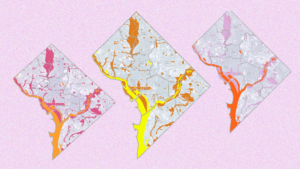The D.C. government will provide a $4 million grant to transform the historic Anacostia neighborhood in Southeast D.C. into an arts and culture district, Mayor Bowser announced on Feb. 23. The grant will fund public beautification, support local artists and art programs, and create opportunities for artists to showcase their work, but critics worry that the funding will accelerate gentrification of the majority-Black neighborhood.
The architects of the grant, Anacostia Business Improvement District Executive Director Kristina Noell and D.C. Arts and Humanities Commissioner Cora Masters Barry, sat alongside Anacostia artists Jay Sun and Mēlani Douglass to discuss the grant with WAMU radio host Kojo Nnamdi at the most recent Kojo in Our Community event on Feb. 28.
“My vision is to find as many ways that I possibly can to pick up some of the siloed ways that we interact and to really find an intergenerational connection point that we really need,” Noell said. “Not just putting the name ‘arts and culture’ on it, but seeing it thrive and being able to amplify that and create a platform for it.”
Barry said that the death of George Floyd galvanized her to push the city to better serve D.C.’s Black residents, including those in Anacostia.
“When you speak to me about arts in Anacostia, that means nothing to the people across town,” Barry said. “They look at east of the river, and out of a $48 million budget [for art], the whole section of this town got $800,000.”
As one of the oldest neighborhoods in the District, Anacostia is a historic and culturally vibrant part of the city. The neighborhood’s landmarks include the home of Frederick Douglass, the colorful Martin Luther King Jr. Avenue, and numerous art centers and galleries.
However, Anacostia’s recent history has been marred by racism and wealth inequality. To avoid the desegregation of D.C. in 1954, the predominantly white neighborhood’s white residents fled, and Anacostia, like the other communities east of the Anacostia River, became majority Black. Public investment and property values subsequently dropped, and since then, Anacostia has become one of the poorest neighborhoods of the District.
According to Barry, the grant will help combat inequity between Anacostia and wealthier areas of D.C. “We want to figure out how to allocate and relabel how we give money, who we give the money to,” Barry said. “As we’re doing that, simultaneously, we want to elevate the arts in the nation’s capital to one of the best art places in the whole United States of America.”
Mēlani Douglass, founder of the Family Arts Museum and director of public programs at the National Museum of Women in the Arts, emphasized that in addition to funding art, the city needs to raise the standard of living for artists in Anacostia. A mother herself, Douglass added that housing is too expensive for young artists, many of whom also have to support families and pay for education. Indeed, D.C. has one of the highest costs of living in America.
“We’ve got to realize that there are real issues that are making it impossible for artists to stay,” Douglass said. “One of them is housing, one of them is around schools, one of them is around where we have to travel just in your day-to-day living.”
According to Barry, the city government offers several programs to subsidize artists in D.C., including housing support and grants for creating artwork. She believes that government support is crucial for preserving Anacostia’s art scene.
“That is how you have sustainability with art,” Barry said. “There’s no reason why you can’t make a living as an artist. The concept that you have to be a starving artist only comes from the lack of the support that the community and the government gives you.”
Nonetheless, some Anacostia residents were wary that increased government attention would invite restrictions on creative freedom, undermining Anacostia’s artistic culture.
“Whenever a state or city or municipal entity comes to a region of the land and gathers the artists, that’s war,” Sun, a filmmaker, musician, and lifetime resident, said. “The artists are the most important people to a culture because they dictate how the people become.”
Other attendees emphasized that the city needs to actively combat gentrification and include the community in decision-making to serve Anacostia’s original residents. Gentrification is not a new phenomenon in the District: young white professionals displaced many historically Black communities in the early 2000s, including Shaw, located around Howard University.
“Change is not always bad,” Keyonna Jones, director of the Congress Heights Arts and Culture Center, said. “But we need to be in the position that we can reap those benefits, and we’re not pushed out.”
Members of the public agreed. “It’s a good step, but only if the community is engaged,” Joel Crooms, a visual artist and longtime resident of Anacostia, told the Voice. “If the community is not engaged, then it’ll be serious gentrification. People will be displaced.”
Moving forward, the architects of the grant hope to invest much more in Anacostia’s art scene. “I’m going to have to raise a lot more money, a whole lot more money, but I’m willing to do it,” Noell said.
Younger artists expressed their gratitude for the city’s attention while reiterating the importance of addressing artists’ needs in their entirety.
“It’s always been art here, and the culture has always been thriving,” Ahmad Woodard, a musician, dancer, and poet, said. “I think it’s just the negative stigmas within east of the river that have always pushed people away.”





